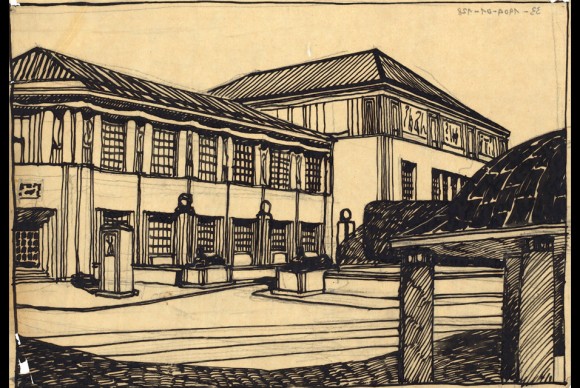Kunsthaus Zürich Shows ‘Karl Moser: Art and Architecture’
ZURICH.- From 17 December 2010 to 27 February 2011 the Kunsthaus Zürich presents about 400 drawings, sketches, models and furniture by Karl Moser (1860-1936), its renowned architect. Revered in Switzerland as a ‘father of modernism’, Moser made architectural history with his contributions to the University of Zurich campus, Basel’s Church of St. Anthony and Badischer Bahnhof, and the Lutherkirche in Karlsruhe. Moser’s 1910 Kunsthaus is a paragon of architecture for art – indeed, of an architecture that collaborates with art; and David Chipperfield’s planned Kunsthaus Zürich extension, renders it appropriate homage.
The scion of a Swiss architectural dynasty, Karl Moser was a man of the world and one of the towering figures who remade modern architecture in the late 19th century and continued to advance the discipline well into the 20th. But although his compatriots saluted him as a ‘father of modernism’ in his own time, Moser was more than just a local hero. For almost 30 years, from 1888 to 1915, when he was appointed professor at ETH Zurich and returned to the land of his birth, Moser ran a large and extremely successful Karlsruhe architecture firm with his partner, Robert Curjel. Back in Switzerland, meanwhile, he was to become the key mentor to a new generation of architects seeking fresh approaches.
GREATEST CONCENTRATION OF MAJOR WORKS IN ZURICH
Moser’s immense oeuvre comprises nearly 600 buildings and projects; the greatest concentration of his major works, pre-eminent among them the Kunsthaus Zürich, which he planned and completed between 1904 and 1910, is to be found in Zurich. The architect drafted numerous plans for extensions to the museum up until his death, and in 1924-1925 did in fact contribute an annex. Other monuments are the main campus of the University of Zurich, which looms above the old town; Fluntern Church; and the Church of St. Anthony in Zurich’s Hottingen neighbourhood. Cities such as Aarau, St. Gallen, Basel, Mannheim, Frankfurt am Main and Kiel are also graced with prominent examples of Moser’s craft, while in Karlsruhe almost 70 of the great man’s constructions, including office blocks, churches and villas, lend a distinct character to entire districts.
ART AND ARCHITECTURE
The Kunsthaus Zürich exhibition is devoted to the manifold skein of relations between the domains of architecture and art as manifest in Moser’s work: his close, lifelong collaboration with such visual artists as Carl Burckhardt, Oskar Kiefer and Max Laeuger; the artistic appointment of his constructions; the rigour of his personal aesthetic standards; his artistic visualization of architectural concepts and his buildings explicitly intended for the world of art. The lavish exhibition, which features some 400 objects, connects elements of Moser’s biography, such as his Karlsruhe period or his acclamation as ‘father of Swiss modernism’, with various special focuses, including pivotal commissions and groups of works, churches, residential buildings, apartments, public monuments, projects and ideas for modern Zurich and independent artistic work.
The main section of the show is displayed in the rooms of the Kunsthaus Zürich’s former exhibition wing, recently renovated in keeping with its status as a heritage building, its interiors partially restored to their original condition. In its furnishings, its chromatic character and its spatial arrangement, the location itself is a work of Karl Moser, and thus affords this particular architectural exhibition the rare opportunity to illuminate a major oeuvre not only with plans and models (3), but by means of a direct encounter with its very venue, itself an example of that oeuvre. The cabinet on the ground floor includes documentation of the Kunsthaus in 1910, its 1925 extension, and Moser’s unrealized projects of the 1930s, while the architect’s collaboration with Ferdinand Hodler and study of his art are the subject of an area of the show located directly below Hodler’s monumental painting ‘Blick in die Unendlichkeit’ on the museum’s first upper level.
Here as elsewhere in the exhibition, 180 of the master’s drawings and plans, 80 of his photographs and selected models are to be juxtaposed with various studies for sculptural decorations and handicrafts representative of the artistic appointment of Moser’s architecture. The furniture (10) in the Hodler Saal is part of the architect’s original fittings. Among the exhibition’s rarities are some 30 fragile plaster models, studies for the decoration of the Kunsthaus façade, drawings for additional sculptural building elements, sketchbooks and 70 other documents illustrative of the use of art in construction.
Related posts:
- Kunsthaus Zürich Shows Videos and Paintings by Albanian Artist Adrian Paci
- Kunsthaus Zürich Presents “Enter the Orbit” with New Works by Roman Ondak
- Kunsthaus Zürich to Stage 15 Exhibitions in 2011 Season, Nahmad Family Collection is a Highlight
- Pablo Picasso Zurich Exhibition Recreates Landmark 1932 Show
- Karl Lagerfeld’s Photos on Display at Maison Europeene de la Photographie

